Submitted by chandra on Thu, 2013-09-19 10:04
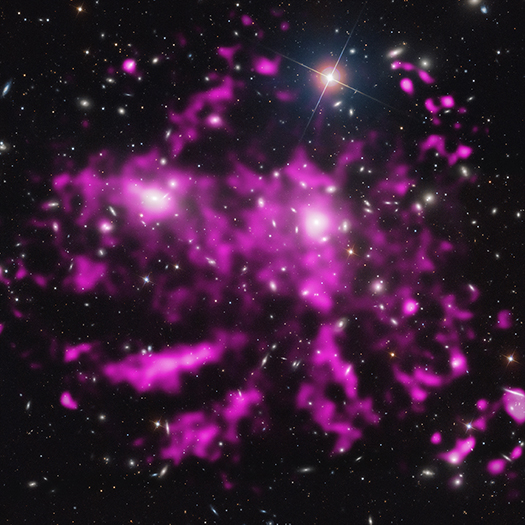
A team of astronomers has discovered enormous arms of hot gas in the Coma cluster of galaxies by using NASA's Chandra X-ray Observatory and ESA's XMM-Newton. These features, which span at least half a million light years, provide insight into how the Coma cluster has grown through mergers of smaller groups and clusters of galaxies to become one of the largest structures in the Universe held together by gravity.
A new composite image, with Chandra data in pink and optical data from the Sloan Digital Sky Survey appearing in white and blue, features these spectacular arms. In this image, the Chandra data have been processed so extra detail can be seen.
Submitted by chandra on Tue, 2012-12-18 11:59
We are very pleased to welcome a guest blogger, Julie Hlavacek-Larrondo, who led the work described in our latest press release. Julie was raised in Montreal, Canada, and in 2007 completed a Bachelor’s degree in physics at the University of Montreal. Julie then obtained a Master’s degree in astrophysics. In 2012, she completed a PhD at the University of Cambridge. She is currently an Einstein Fellow at Stanford University.
It was during my Master degree at the University of Montreal that I realized just how fascinating black holes are.
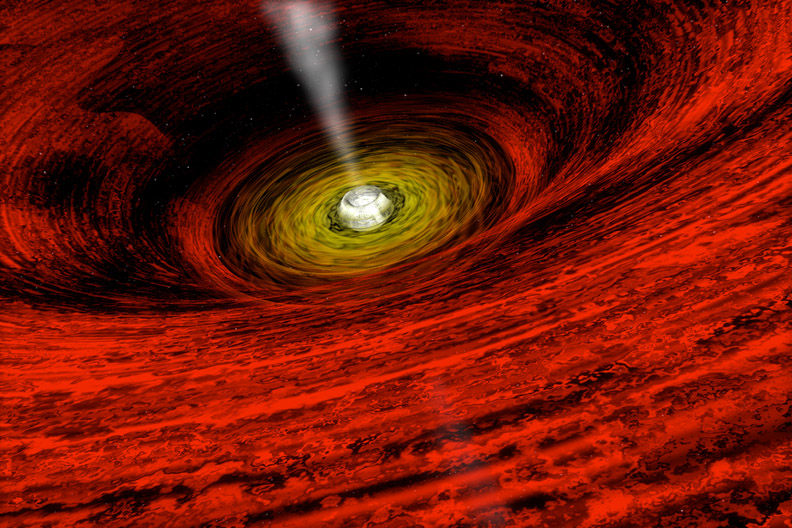
I remember stumbling upon a press release from Chandra in 2007. The Chandra space telescope revealed an image of a jet, powered by a supermassive black hole, blasting through its neighboring galaxy. What's so fascinating? Supermassive black holes are tiny objects, about a billion times smaller than the galaxy it resides in, yet, it can create jets that extend well beyond the size of the galaxy! How can something so small be so powerful?
Submitted by chandra on Tue, 2012-12-18 11:50
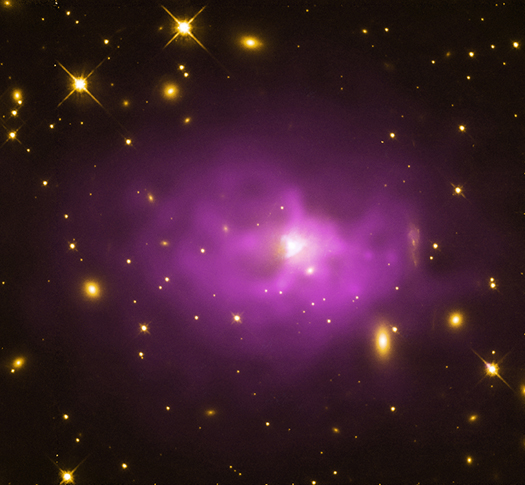
The black hole at the center of this galaxy is part of a survey of 18 of the biggest black holes in the universe. This large elliptical galaxy is in the center of the galaxy cluster PKS 0745-19, which is located about 1.3 billion light years from Earth. X-ray data from NASA's Chandra X-ray Observatory are shown in purple and optical data from the Hubble Space Telescope are in yellow.
Submitted by chandra on Wed, 2012-08-08 12:13
For more background about the Phoenix Cluster, including how it was discovered and the meaning of its adopted name, we have interviewed the first author Michael McDonald. Michael has recently started a Hubble postdoctoral Fellowship at the Kavli Institute for Astrophysics and Space Research at the Massachusetts Institute of Technology. He received Bachelor degrees and a Masters of Science from Queen’s University in Canada, and a PhD from the University of Maryland.
Submitted by chandra on Tue, 2012-08-07 13:08
It's not every day that we can mention "Chandra" and the "Olympics" in the same sentence, but today we can. That's because Stacie Powell, who will compete in the 10-meter platform diving competition for Great Britain at the London Olympics beginning today, is also working on her Ph.D. in astrophysics.
Submitted by chandra on Thu, 2012-04-12 14:32
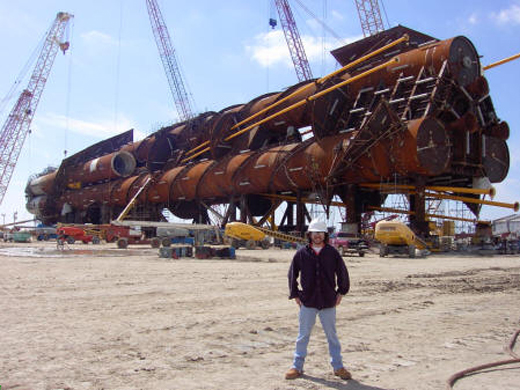 Will Dawson standing next to the Red Hawk cell spar (currently installed in the Gulf of Mexico).
Will Dawson standing next to the Red Hawk cell spar (currently installed in the Gulf of Mexico).Astronomy can generate a large amount of attention from the public, but the number of working astronomers is smaller than the number of researchers in many other academic fields. So, when people get over their surprise at meeting a real astronomer, they often ask "How did you end up working in this field?". There are many different answers, but an interesting one is provided here by Will Dawson from the University of California, Davis, who kindly explains his career change from engineering to astronomy. We were very satisfied to hear that part of his motivation for this big change came from the publicity generated by the Bullet Cluster in 2006.
Will is the first author of a recent paper describing the discovery of the Musket Ball Cluster.
What field did you work in before astronomy?
After graduating with my bachelor of science degree in Maritime Systems Engineering from Texas A&M at Galveston in 2002, I went to work in the offshore engineering industry at Technip. During my four years with Technip I was primarily involved with the design and analysis of Spars, which are floating offshore oil production platforms (essentially stiffened steel cylinders roughly 90 feet in diameter, 550 feet long and 25,000 tons).
What inspired you to change fields?
Submitted by chandra on Thu, 2012-04-12 09:19
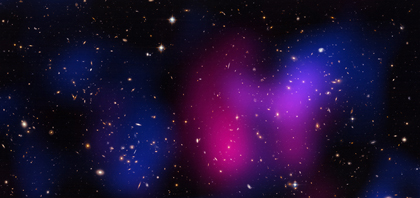
Using a combination of powerful observatories in space and on the ground, astronomers have observed a violent collision between two galaxy clusters in which so-called normal matter has been wrenched apart from dark matter through a violent collision between two galaxy clusters.
The newly discovered galaxy cluster is called DLSCL J0916.2+2951. It is similar to the Bullet Cluster, the first system in which the separation of dark and normal matter was observed, but with some important differences. The newly discovered system has been nicknamed the "Musket Ball Cluster" because the cluster collision is older and slower than the Bullet Cluster.
Submitted by chandra on Wed, 2012-03-14 10:23
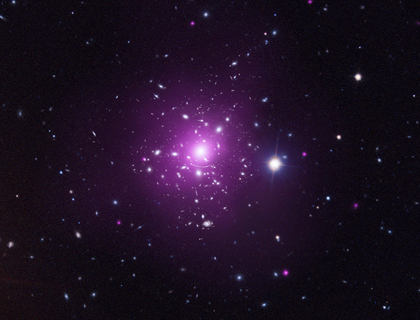
Two teams of astronomers have used data from NASA's Chandra X-ray Observatory and other telescopes to map the distribution of dark matter in a galaxy cluster known as Abell 383, which is located about 2.3 billion light years from Earth. Not only were the researchers able to find where the dark matter lies in the two dimensions across the sky, they were also able to determine how the dark matter is distributed along the line of sight.
Submitted by chandra on Fri, 2012-03-02 12:29

This composite image shows the distribution of dark matter, galaxies, and hot gas in the core of the merging galaxy cluster Abell 520, formed from a violent collision of massive galaxy clusters that is located about 2.4 billion light years from Earth.
Submitted by chandra on Tue, 2012-01-10 11:19
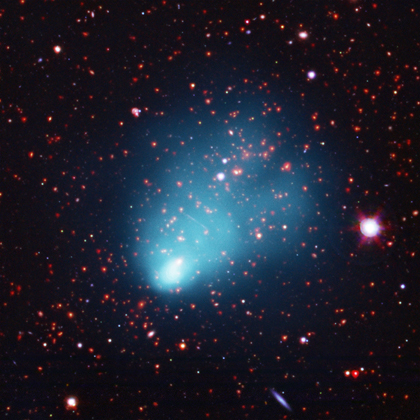
A composite image shows El Gordo in X-ray light from NASA's Chandra X-ray Observatory in blue, along with optical data from the European Southern Observatory's Very Large Telescope (VLT) in red, green, and blue, and infrared emission from the NASA's Spitzer Space Telescope in red and orange.
Pages